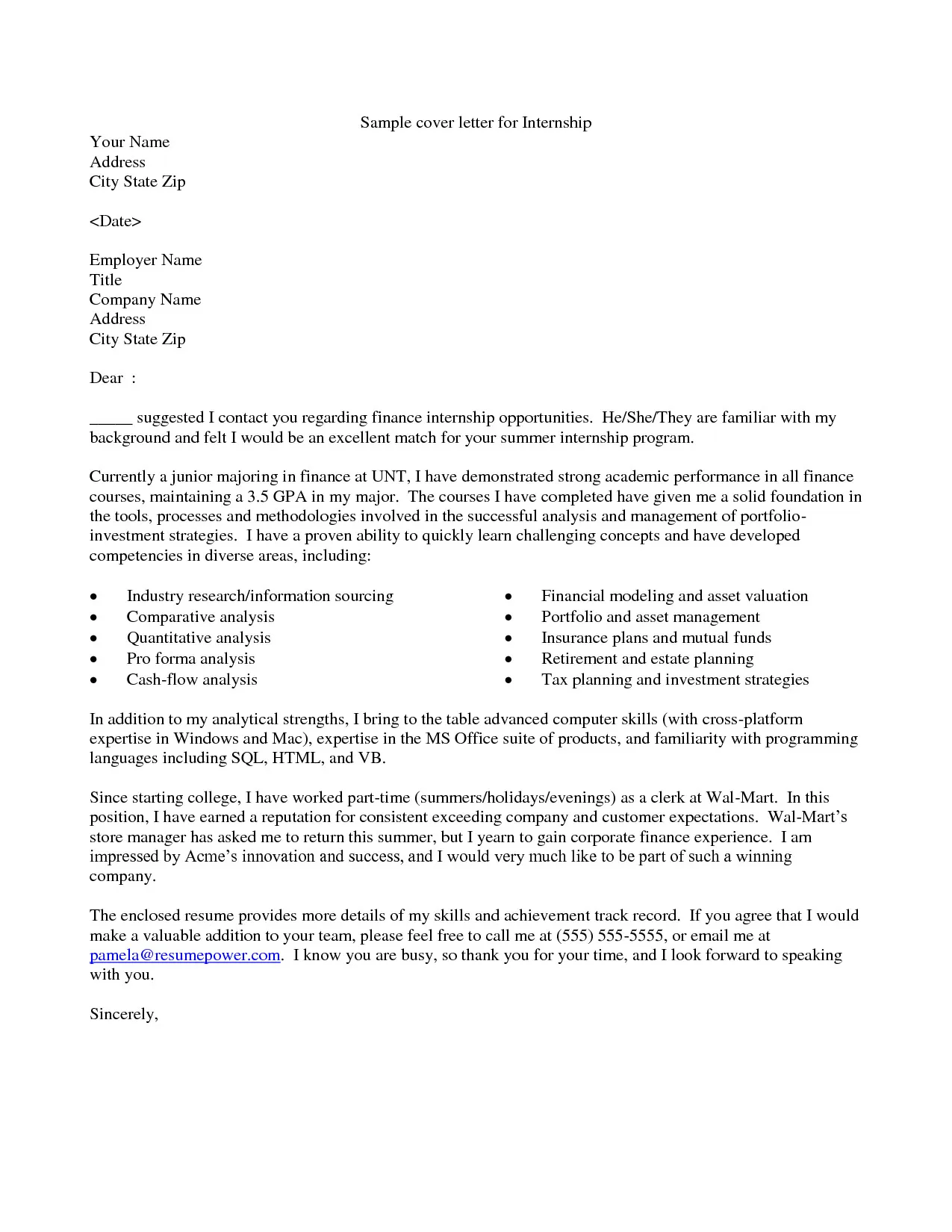Why a Cover Letter for Internship Matters
In the competitive world of internships, a well-crafted cover letter can be your golden ticket. It’s more than just a formality; it’s your first chance to make a strong impression on potential employers. While your resume provides a snapshot of your skills and experience, a cover letter allows you to showcase your personality, explain your motivations, and demonstrate how your aspirations align with the internship opportunity. It’s a critical component that allows you to communicate your unique value proposition, setting you apart from other applicants who may have similar qualifications. A thoughtfully written cover letter reflects your attention to detail, your communication skills, and your genuine interest in the specific internship, making it an indispensable part of your application package. It helps to build the bridge between your resume and the job, creating the context to understand your application.
Crafting a Compelling Cover Letter for Internship
Crafting a compelling cover letter involves a strategic approach that goes beyond simply listing your qualifications. It’s about telling a story that resonates with the employer and captures their attention from the start. Begin by researching the company and the specific internship role to tailor your letter to their needs and values. Then, focus on highlighting the most relevant skills and experiences that make you an ideal candidate, using specific examples to demonstrate your achievements. Finally, ensure that your letter is well-structured, free of errors, and reflects your enthusiasm for the opportunity. Remember to showcase your understanding of the company’s mission and how your goals align with their objectives. This targeted approach makes your cover letter stand out and significantly increases your chances of securing an interview and the internship.
Header Essentials

The header of your cover letter sets the tone and provides essential information at a glance. A clean and professional header is critical for creating a positive first impression. It should start with your full name, contact information (phone number and professional email address), and, optionally, links to your LinkedIn profile or online portfolio. Ensure all contact details are current and accurate. This section should be concise and easy to read, using a standard font and simple formatting. A well-designed header not only provides necessary contact information but also immediately conveys professionalism and attention to detail, signaling to the employer that you take your application seriously. Furthermore, this section ensures that the employer can easily contact you. Be sure to check this section thoroughly before sending your application.
Contact Information
Your contact information is the gateway for the employer to reach you. Include your full name, a professional email address (avoid nicknames or unprofessional addresses), and a phone number where you can be easily reached. Consider using a separate email address for job applications to keep your professional and personal communications distinct. Ensure your voicemail is set up and professionally recorded. Double-check all information for accuracy to prevent any communication barriers. Providing accurate contact details ensures the employer can quickly and efficiently reach you if they are interested in moving forward with your application. Make certain this information is up-to-date to ensure you don’t miss out on any opportunities.
Date and Recipient Information
Following your contact details, include the date and the recipient’s information. Start with the current date, followed by the hiring manager’s name, title, and the company’s address. If you know the name of the hiring manager, address the letter to them directly. This personal touch shows you’ve done your research and demonstrates your attention to detail. If you cannot find a name, use a general salutation such as “Dear Hiring Manager.” Use a formal tone and ensure all information is accurate to create a professional and polished application. Taking the extra step to personalize your cover letter shows a level of interest and respect that can make a significant difference.
Opening Paragraph Grabbing Attention
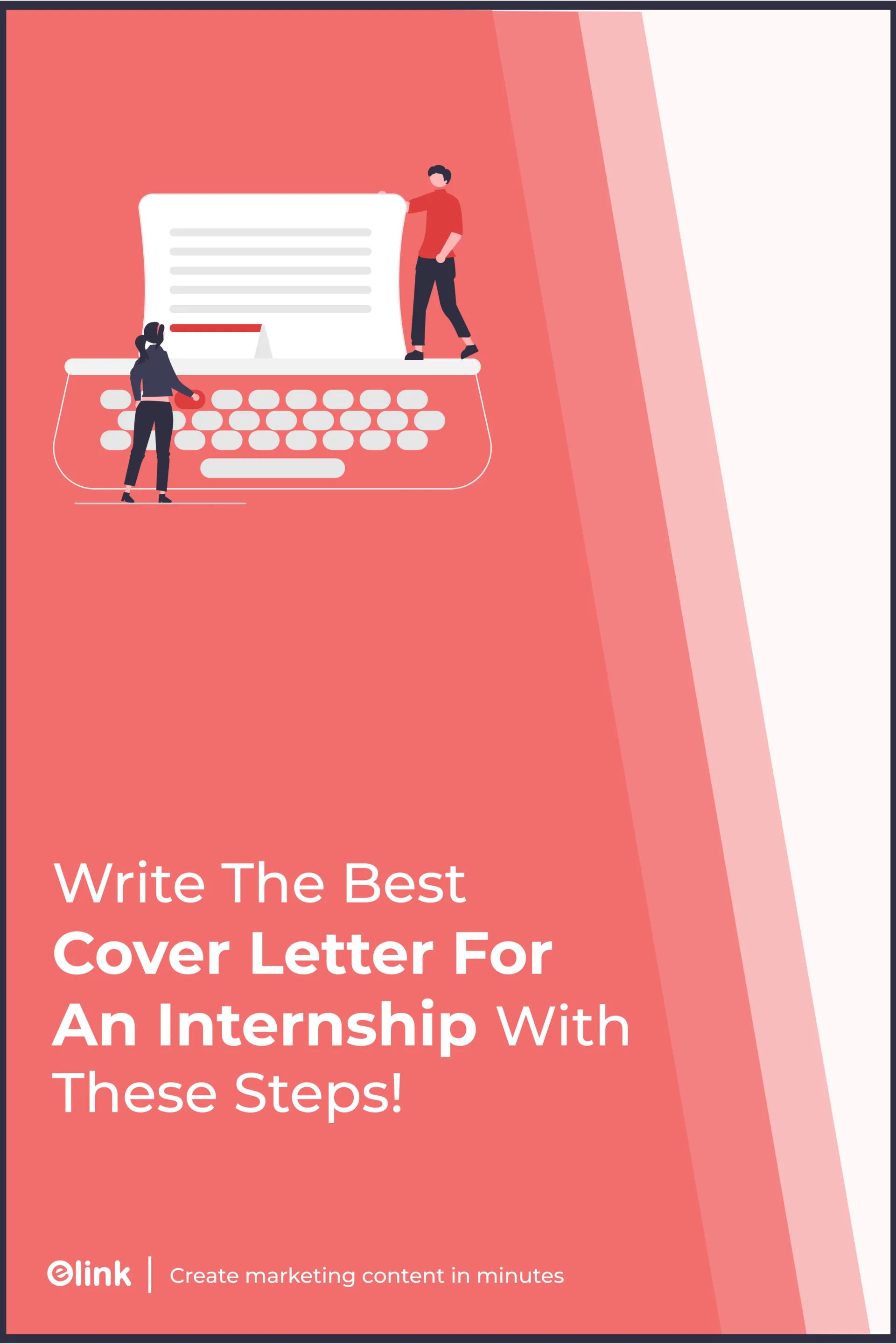
The opening paragraph is your first opportunity to grab the employer’s attention and make them want to read more. It should be concise, engaging, and immediately convey why you are writing. State the specific internship you are applying for and where you found the listing. Then, briefly mention your key qualifications and your enthusiasm for the opportunity. Personalize your opening by mentioning something specific about the company that appeals to you. This might be their mission, a recent project, or an aspect of their culture. This tailored approach demonstrates that you’ve researched the company and are genuinely interested in the role. It’s your hook – the part that convinces the reader to keep reading.
Highlighting Your Interest and Enthusiasm
Demonstrating your enthusiasm is crucial. Express a genuine interest in the internship and the company. Explain why you are drawn to this particular opportunity and what excites you about the prospect of joining their team. Show that you understand the company’s mission, values, and recent achievements. Refer to specific aspects of the internship that align with your career goals and academic background. Highlighting what you hope to gain and contribute during the internship will not only show your enthusiasm but also your proactive approach. This demonstration of genuine interest can significantly boost your application, setting you apart from other applicants. Consider including something specific about the company’s recent achievements or values that appeal to you.
Showcasing Relevant Skills
The main body of your cover letter is the place to showcase your relevant skills and experiences. Carefully review the internship description and identify the key skills and qualifications the employer is seeking. Then, demonstrate how your skills and experiences align with these requirements. Use specific examples to illustrate your capabilities. Discuss your academic projects, previous internships, extracurricular activities, or volunteer work. Focus on what you accomplished, how you did it, and what results you achieved. By providing concrete evidence of your skills, you reassure the employer that you can contribute positively to their team. Use action verbs to describe your accomplishments, making your descriptions more dynamic and engaging. It should directly correlate with the skills required in the job posting.
Linking Skills to Internship Requirements

A critical step is explicitly linking your skills to the internship requirements. Do not simply list your skills; connect them to the specific needs outlined in the job description. For each key skill, provide a brief example of how you have used it in the past and what the outcome was. This approach demonstrates that you understand the role and are ready to apply your skills to the company’s goals. For instance, if the internship description requires strong communication skills, mention a project where you effectively presented your ideas or facilitated discussions. Ensure this alignment is clear and concise, showing the hiring manager that you understand what the role requires and can deliver. This strategic alignment increases the relevance and impact of your cover letter.
Providing Concrete Examples
Avoid vague statements and use concrete examples to demonstrate your skills and achievements. Instead of saying, “I have strong leadership skills,” describe a specific situation where you led a team, the challenges you faced, and the positive outcomes you achieved. Quantify your achievements whenever possible. For example, instead of saying “Improved customer satisfaction,” state “Increased customer satisfaction by 15%.” Using concrete examples gives the hiring manager a clear picture of your abilities and provides tangible evidence of your past successes. Select examples that are most relevant to the internship role and highlight your transferable skills, making it easier for the employer to envision you in the position. Make sure each example you provide is related to a job duty mentioned in the job description.
Quantifying Your Achievements
Quantifying your achievements adds significant impact to your cover letter, providing tangible evidence of your capabilities. Wherever possible, use numbers, percentages, and specific data to demonstrate your accomplishments. For example, instead of saying “Managed social media accounts,” state “Grew social media engagement by 30% in six months by implementing a new content strategy.” This allows the hiring manager to easily assess your impact and see the value you can bring to the internship. Providing quantifiable results not only reinforces your claims but also showcases your ability to analyze data and achieve measurable outcomes. It’s far more effective to say that you achieved a specific measurable outcome rather than just stating you completed a certain task.
Addressing the Employer’s Needs
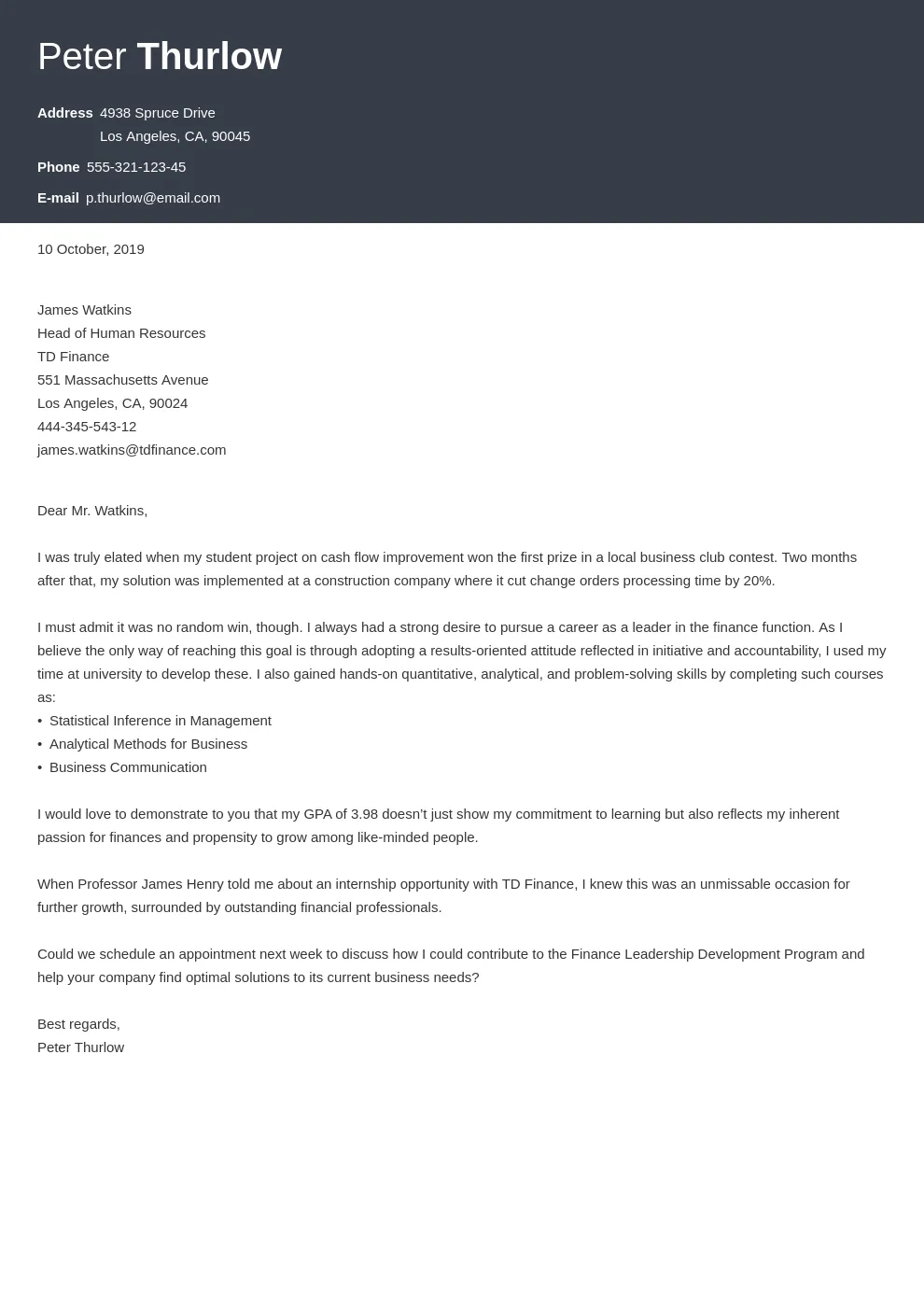
Your cover letter should not just be about you; it should also demonstrate how you can meet the employer’s needs. Research the company and the specific internship role. Understand their goals, challenges, and values. Then, tailor your letter to show how your skills and experiences align with their needs. Highlight how your contributions can help them achieve their objectives. For example, if the internship focuses on a specific project, explain how your skills make you well-suited to contribute to its success. Always show how you, as an intern, can deliver value. This focus makes you more attractive to the employer and increases the likelihood of securing an interview, making your application relevant and compelling.
Matching Your Skills to the Job
Carefully review the internship description and create a matrix or list to match your skills with the job requirements. Identify the key skills the employer is seeking and explicitly state how your skills align with those requirements. For each skill, provide a brief example of how you have demonstrated it in the past, either through coursework, projects, or previous experiences. This demonstrates that you have the necessary skills and that you understand the role’s expectations. By directly addressing the job requirements, you make the hiring manager’s job easier and increase your chances of standing out as a well-suited candidate. Make sure the relevant skills are easily identifiable in your cover letter, allowing the reader to quickly see the value you bring to the internship.
Demonstrating Your Understanding of the Company
Demonstrating your understanding of the company is a crucial step in impressing potential employers. Show that you have researched the company by mentioning its mission, values, or recent achievements. This can be done by referring to a specific project, product, or initiative that resonates with you and explaining why. Your understanding of the company’s work demonstrates genuine interest and shows that you are not simply sending out generic applications. Mentioning the company’s recent projects, values, and news also indicates your motivation to be part of the team. This thoughtful approach goes beyond simply listing your qualifications, signaling to the employer that you are seriously interested in the internship opportunity and prepared to contribute effectively.
Closing the Deal a Strong Conclusion
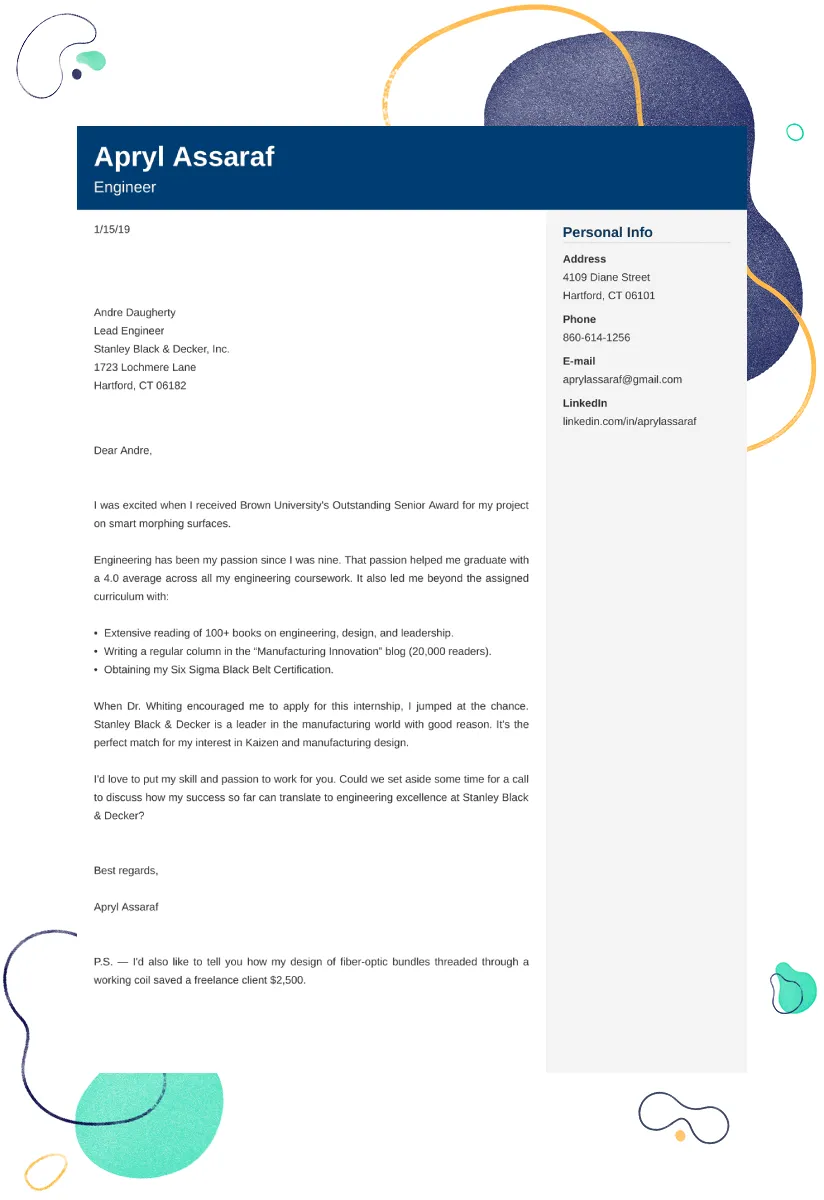
Your conclusion should leave a lasting positive impression. It should be concise and reiterate your interest in the internship. Reiterate the value you can bring to the role and the company, summarizing your key qualifications. Always express your gratitude for the opportunity to be considered, thanking the hiring manager for their time and consideration. Include a call to action, such as stating your availability for an interview. Ensure your closing is professional and reflects the enthusiasm you expressed throughout your cover letter. A well-crafted conclusion reaffirms your interest and leaves the employer with a positive and memorable impression.
Restating Your Interest and Availability
Reiterate your keen interest in the internship in the closing paragraph. Remind the hiring manager why you are a strong candidate and highlight your enthusiasm for the opportunity. State your availability for an interview, making it easy for the employer to move forward. Be clear about your contact information, and if you are available for an interview immediately, state that explicitly. This ensures that the hiring manager knows how to contact you and that you are ready and eager to take the next steps. This proactive approach demonstrates your commitment to the internship and increases your chances of being selected.
Expressing Gratitude
Always express your gratitude to the hiring manager for their time and consideration. Thank them for reviewing your application and for the opportunity to be considered for the internship. Expressing gratitude leaves a positive and professional impression, showing respect for the hiring process. Make the closing paragraph about the employer, not yourself, showcasing your understanding and respect for their efforts. This gesture of appreciation can leave a lasting, positive impression, especially if combined with the rest of your application. It demonstrates your professionalism and enhances your candidacy.
Professional Formatting and Proofreading
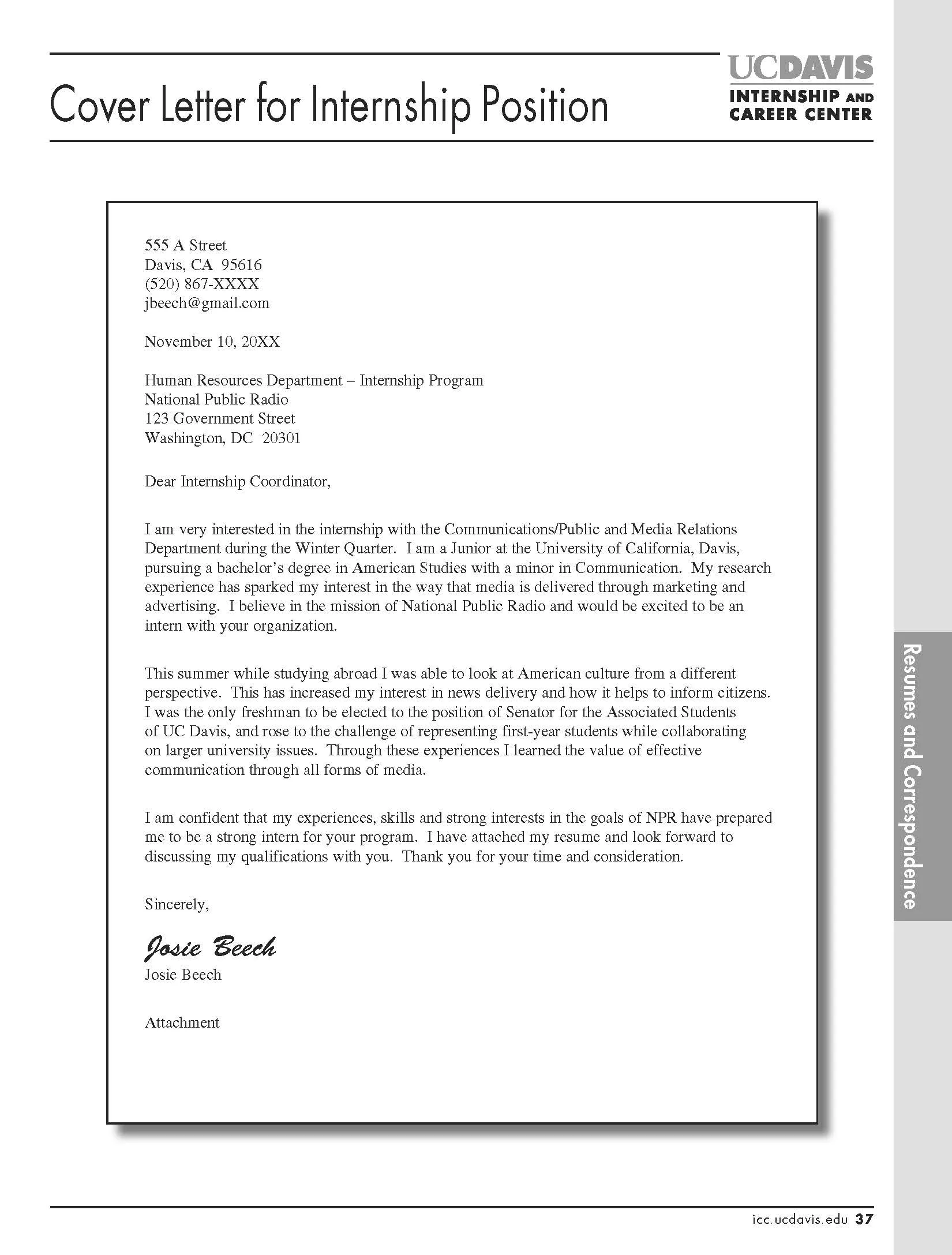
Professional formatting and meticulous proofreading are essential elements of a successful cover letter. It demonstrates that you care about detail, and you respect the employer’s time. Ensure your letter is free of grammatical errors, typos, and formatting inconsistencies. Use a clear, professional font and consistent formatting throughout the document. Proper formatting makes your cover letter easy to read and visually appealing, while accurate proofreading eliminates errors that could detract from your qualifications. Proofread your letter several times and consider having a friend or career counselor review it as well. Pay special attention to the language; make sure it is formal and clear.
Font and Formatting Choices
Choose a professional and readable font, such as Times New Roman, Arial, Calibri, or Helvetica. Maintain a consistent font size (typically 11 or 12 points) and use consistent formatting, including line spacing, paragraph breaks, and margins (usually one inch). Ensure your letter is easy on the eyes by using appropriate white space. Avoid overly elaborate fonts or unnecessary formatting elements, which can distract the reader. Use boldface and italics sparingly, and use them only to emphasize key points. A well-formatted cover letter demonstrates your attention to detail and makes your application look professional and polished. Proper formatting increases readability.
Proofreading and Editing Checklist
Before submitting your cover letter, conduct a thorough proofreading and editing session. Use a checklist to catch any errors. Check for grammatical errors, spelling mistakes, punctuation issues, and any typos. Verify that your contact information, the date, and the recipient information are all accurate. Ensure that the content aligns with the job description, and all relevant information is included. Check the formatting, making sure it is consistent throughout. Then, consider asking a trusted friend, family member, or career counselor to proofread your cover letter as well. Another set of eyes can often catch errors you might have missed. Meticulous proofreading and editing are vital for showing you care about the opportunity.
